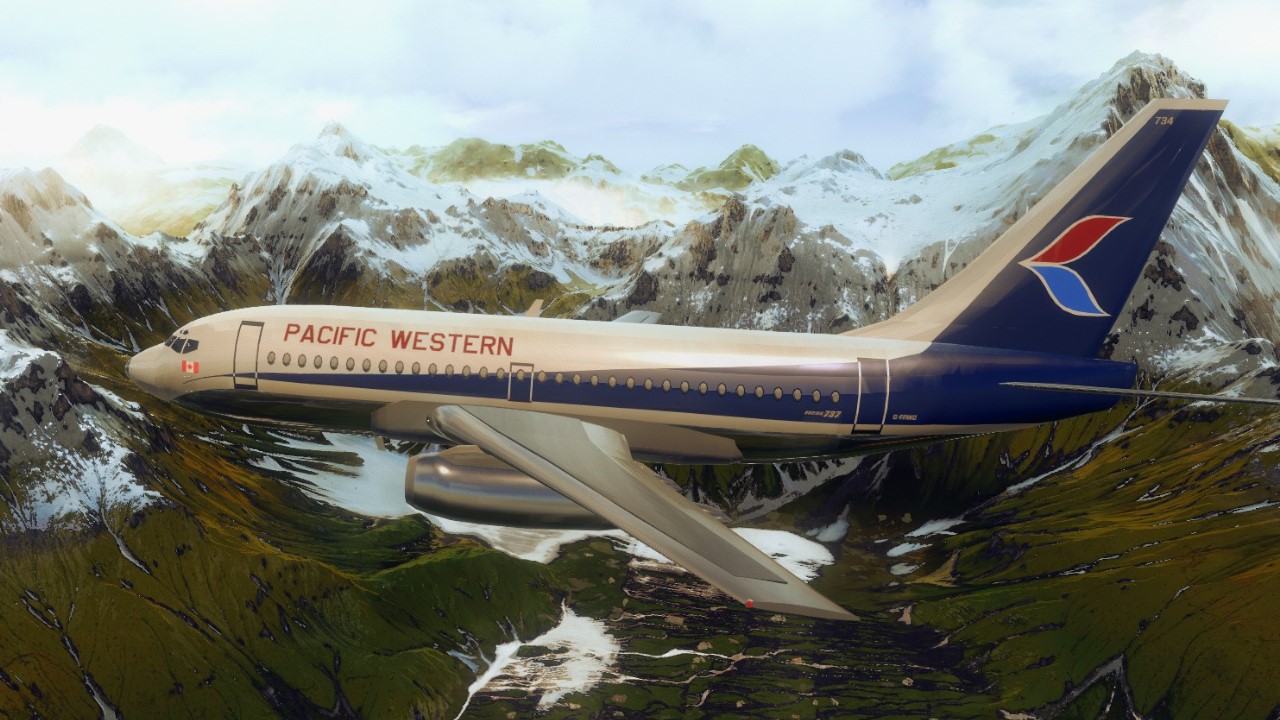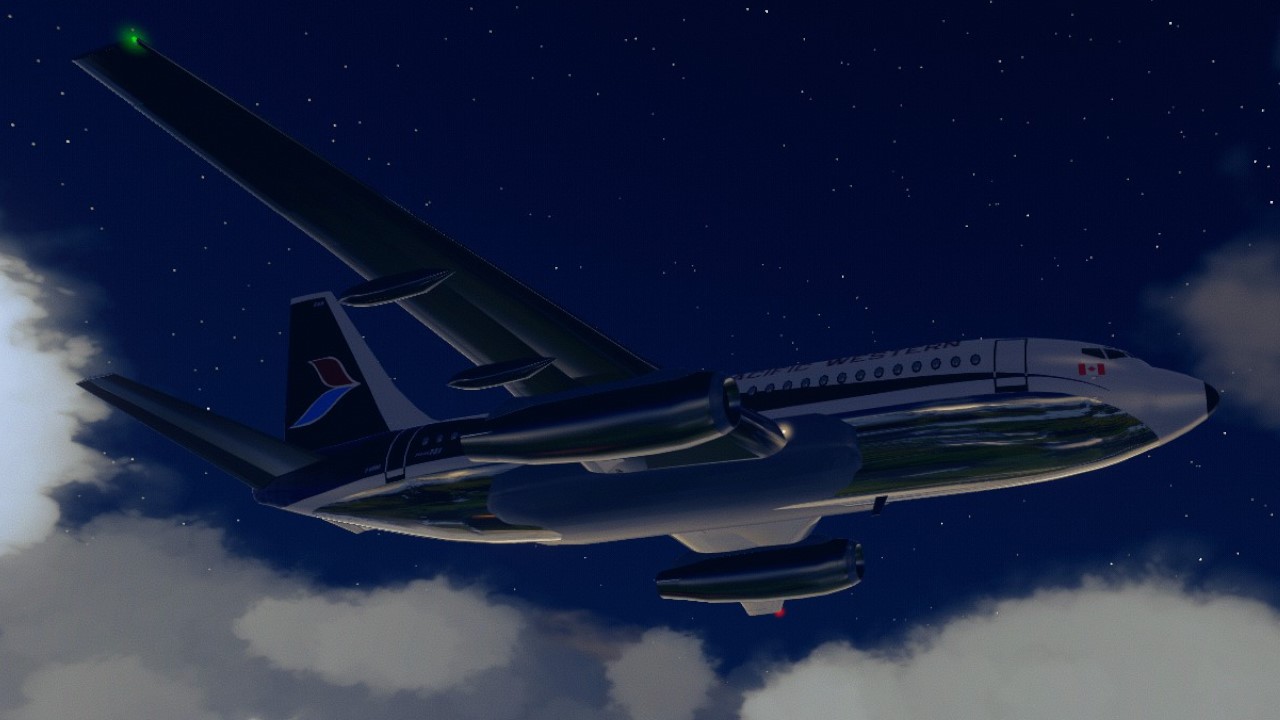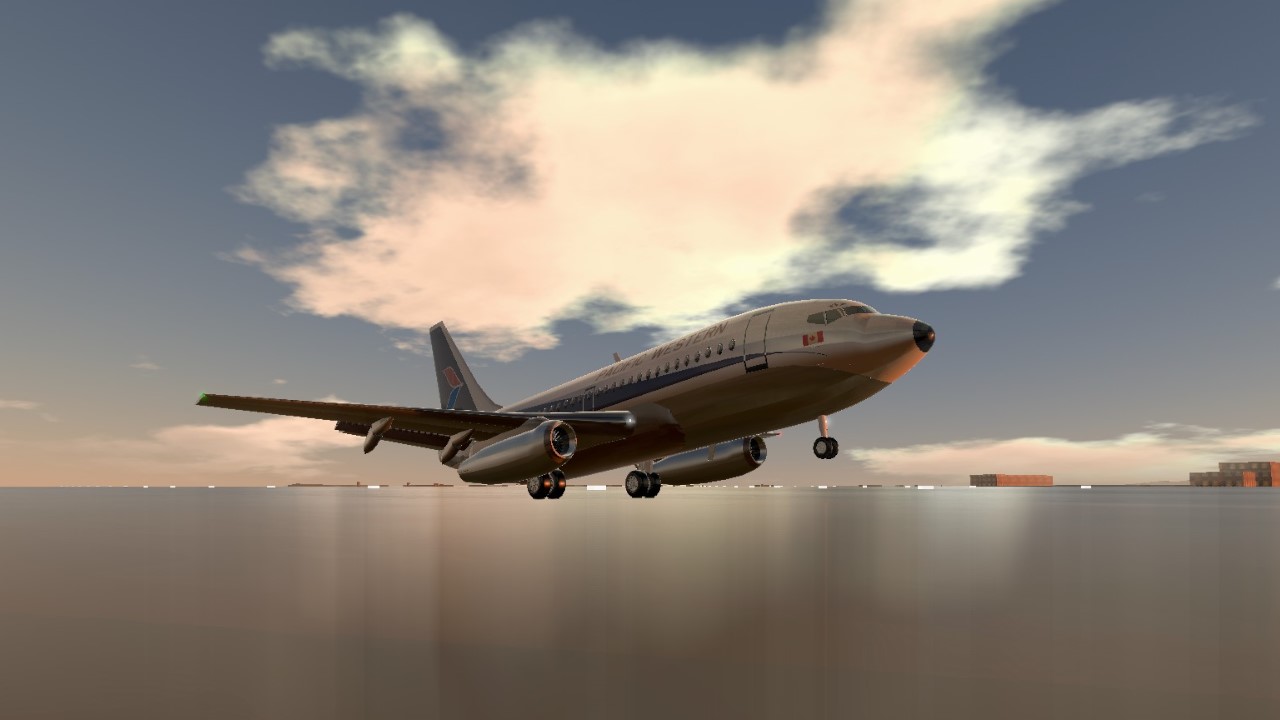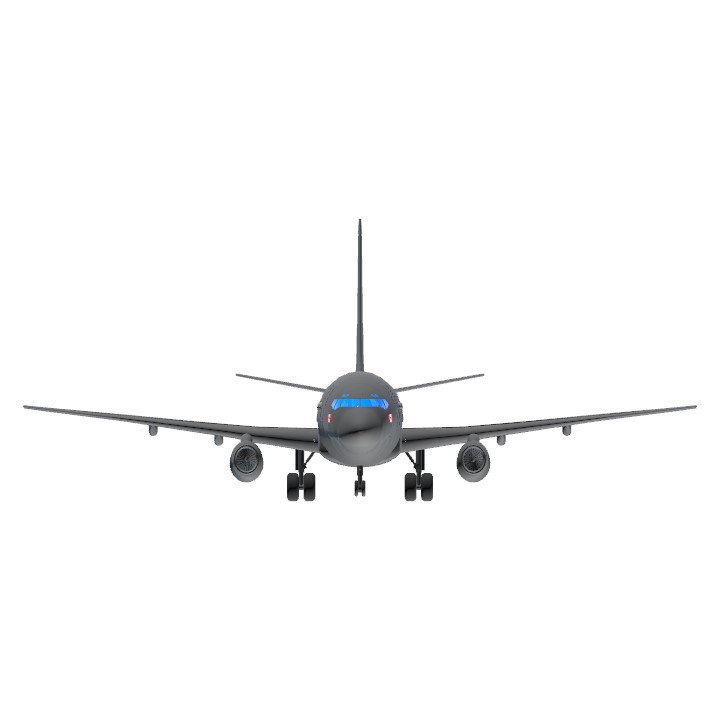Credit for the original template aircraft goes to XAircraftManufacturer's XJ-737-200
Aircraft/Livery request and screenshots from CanadianAircraftBuilder
Edit: 10/29/24: Godspeed Canadian, wherever you are. This post marked the start of a friendship that abruptly ended without explanation. If you're out there and see this, I salute you.
Controls are in game
About the Boeing 737 & -200 Variant
The Boeing 737 is a narrow-body aircraft produced by Boeing at its Renton Factory in Washington. Developed to supplement the Boeing 727 on short and thin routes, the twinjet retains the 707 fuselage width and six abreast seating with two underwing turbofans. Envisioned in 1964, the initial 737-100 made its first flight in April 1967 and entered service in February 1968 with Lufthansa. The lengthened 737-200 entered service in April 1968, and evolved through four generations, offering several variants for 85 to 215 passengers.
The 737-100/200 original variants were powered by Pratt & Whitney JT8D low-bypass engines and offered seating for 85 to 130 passengers. Launched in 1980 and introduced in 1984, the 737 Classic -300/400/500 variants were upgraded with CFM56-3 turbofans and offered 110 to 168 seats. Introduced in 1997, the 737 Next Generation (NG) -600/700/800/900 variants have updated CFM56-7s, a larger wing and an upgraded glass cockpit, and seat 108 to 215 passengers. The latest generation, the 737 MAX, 737-7/8/9/10 MAX, powered by improved CFM LEAP-1B high bypass turbofans and accommodating 138 to 204 people, entered service in 2017.
The 737-200 was a 737-100 with an extended fuselage, launched by an order from United Airlines in 1965 and entered service with the launch customer in April 1968. The 737-200 Advanced became the production standard in June 1971. Boeing also provided the 737-200C (Combi), which allowed for conversion between passenger and cargo use and the 737-200QC (Quick Change), which facilitated a rapid conversion between roles. The 1,095th and last delivery of a -200 series aircraft was in August 1988 to Xiamen Airlines.

The first 737-200 ever delivered to launch customer United Airlines (Registration N9001U) at Cleveland Hopkins International Airport (ICAO: KCLE/ IATA: CLE) in 1975.
After 40 years, in March 2008, the final 737-200 aircraft in the U.S. flying scheduled passenger service were phased out, with the last flights of Aloha Airlines. The variant still sees regular service through North American charter operators such as Sierra Pacific, Canadian North, Air Inuit, Nolinor and Chrono. Cargo variants continue to operate today such as Transair and Aerosucre, while passenger variants can be found in second and third rate airlines of developing nations such as Air Zimbabwe.
737-200 Specs. & Info
-Length: 100ft 2in/30.53m
-Wingspan: 93ft/28.35m
-Height: 36ft 10in/11.23m
ICAO/IATA Type Designations
ICAO: B732
IATA: 732

The classic cockpit of a WestJet 737-2A3 on display at the Newcastle Aviation Academy (Registration C-GWJO) at Newcastle International Airport (ICAO: EGNT/IATA: NCL)

The cabin of a United Airlines 737-222 (Registration: N9042U) at Lewis University Airport (ICAO: KLOT/IATA: LOT)

A Ryanair 737-204Adv (Registration: EI-CJC) at Nuremberg Airport (ICAO: EDDN/ IATA: NUE) on November 30th, 2001. Yes, I had to find a way to put Ryanair in here somehow.
About Pacific Western Airlines
IATA Code: PW
ICAO Code: PWA
Callsign: PACIFIC WESTERN AIRLINES
Primary Hubs: Calgary International Airport (ICAO: CYYC/IATA: YYC) & Vancouver International Airport, (ICAO: CYVR/IATA: YVR)
Headquarters: Richmond, British Columbia, (1946-1974) & Calgary, Alberta (1974-1987)
Years Active: 1946-1987

The Pacific Western logo as seen from 1985

A Pacific Western DC-3, CF-PWI, at Vancouver International Airport (ICAO: CYVR / IATA: YVR) in 1959

A Pacific Western Boeing 727-271C (Registration C-FPXD) at Edmonton International Airport (ICAO: CYEG/IATA: YEG) in August of 1981 wearing the retro livery.

A Pacific Western Boeing 767-275 (Registration: C-GPWA) at Vancouver International Airport on April 30th,1983, wearing the airline's updated livery.
Pacific Western Airlines was an airline that operated scheduled flights throughout western Canada and charter services around the world from the 1950s through the 1980s. It was headquartered at Vancouver International Airport in Richmond, British Columbia, until 1974, when the head office was moved to Calgary, Alberta. Pacific Western Airlines was a pioneer in the aviation history and known for its ability to profitably operate short haul air routes. Pilots provided air service to remote mining camps and logging operations in the North, delivering men and materials to isolated destinations.
In 1949, PWA predecessor Central B.C. Airways was commissioned to do aerial surveys for the aluminum and power complexes in the rugged mountainous backcountry of British Columbia. During the development of this project, Central B.C. Airways handled 95% of the air support, consisting mainly of heavy industrial freight and workers. Between 1949 and 1952, the company acquired seven other smaller flying services. With each acquisition, the company expanded its base of operations, providing the much needed manpower and equipment necessary to maintain a rapidly expanding air service. In 1953, the company adopted the name Pacific Western Airlines. In 1959, Pacific Western was part of the largest single transfer of scheduled services in Canadian aviation history. In that same year, Canadian Pacific Airlines released licensed routes from Edmonton to 18 destinations in Northern Alberta and the Northwest Territories. With this transfer, in addition to its existing routes, Pacific Western was licensed to provide scheduled air services over approximately 7,000 miles throughout Western and Northern Canada.
In 1966, in anticipation of a regional air policy for Canada, Pacific Western began placing orders for jet and turboprop equipment. The regional policy became a reality in 1968, and the company was able to add many more ports of call to the already long list of destinations in Western Canada. Services at this point stretched from the U.S Pacific Northwest to the Arctic Archipelago.
The Boeing 707 was first added to the fleet in 1967, serving several tour programs to Hawaii and Mexico along with several European destinations served during the summer on a charter basis. The company aircraft visited more than 90 countries during this period of time. Pacific Western operated a worldwide Boeing 707 cargo and passenger charter program until the last aircraft was sold in 1979.
In November 1968, the company introduced jet service on its scheduled route system with the delivery of its first Boeing 737-200 jetliner. Pacific Western was the first Canadian carrier to order the 737, adding it to its fleet of turboprop and turbojet aircraft, Pacific Western provided scheduled air service throughout British Columbia, Alberta and the Northwest Territories. By 1969, the "Chieftain Airbus" shuttle service between Calgary and Edmonton was being flown with Boeing 737-200's, Convair 640's and Douglas DC-6's.
As the 1970s progressed, the airline's equipment varied and the company began a fleet rationalization program, concentrating on the 117-seat Boeing 737-200 as the backbone of the mainline fleet. During the mid 1970s, Pacific Western was operating Boeing 727-100C jetliners in addition to its Boeing 737-200 and -200C aircraft. By the late 1970s, the company operated an all-jet mainline fleet.
In 1987, PWA Corp, the parent corporation of Pacific Western Airlines, purchased Canadian Pacific Airlines to form Canadian Airlines International. Wardair, another Canadian airline, was later purchased by PWA in 1989, resulting in only two major airlines in Canada: Canadian Airlines International and Air Canada. PWA and later Canadian airlines were based in Calgary. In December 1999, Air Canada took over Canadian Airlines International.
Pacific Western Airlines Flight 314: Ahead of Schedule

The accident aircraft (Registration C-FPWC) at Vancouver International Airport in May, 1977.
On February 11th, 1978, a Boeing 737-275 registered as C-FPWC was operating as Pacific Western Airlines 314 with a flight from Edmonton International Airport to West Kootenay Regional Airport (ICAO: CYCG/IATA: YCG) with a first stopover at Calgary International Airport and a second stopover at Cranbrook/Canadian Rockies International Airport (ICAO: CYXC/IATA: YXC). Onboard are 49 occupants, 44 passengers, 3 flight attendants, and 2 pilots. In the cockpit is 30 year old Captain Chris Miles with 5,173 flight hours, 2,780 hours of which were on the Boeing 737, and 25 year old first officer Peter Van Oort, with 1,316 flight hours, 81 of which were in the 737. At 12:32 local time, the aircraft departs Calgary for Cranbrook.
Anyone living in northern latitudes knows that winter months can be unpleasant, and this day was no different with heavy snowfall and visibility at only 3/4mile/1.21km. On the runway at Cranbrook is a snowplow and its operator Terry George, who receives the ETA of incoming aircraft so that he can remain on the runway for as long as possible to continue to remove snow. Calgary gives Cranbrook and estimated ETA for PWA 314 of 13:05. It should be noted that Cranbrook was not a controlled airport at the time, and only possessed ground equipment and an 'aeradio' operator which updated weather and runway conditions.
The standard approach into Cranbrook involved pilots making a loop around a radio beacon known as the 'Skookum Beacon' several miles north of the airport, which would then bring them straight in to the airport. This maneuver added several minutes to flights. Pilots were supposed to report passing the beacon and reporting when they were on final approach. At 12:46 whilst descending from FL180, PWA 314 contacted Cranbrook Aeradio and was passed the latest weather and runway information. Cranbrook Aeradio then advised Flight 314 that there was a snowplow out on the runway removing snow. First Officer Van Oort acknowledged this information.
For unknown reasons, Captain Miles decided to not to the standard circle maneuver around the beacon and instead come straight in to Runway 16. This put the aircraft on a new arrival 10 minutes ahead of time of their 13:05 ETA. Captain Miles also did not report passing the beacon nor reporting that they were on final approach, so Terry George had no idea that a 737 was incoming earlier than expected, and thus, was still on the runway.
At 12:55, PWA 314 touched down about 800ft/240m from the runway threshold. The pilots did not see the snowplow due to poor visibility, as well as the fact that the snowplow produced a plume of snow which obscured it. The throttles were reduced to idle and reverse thrust was engaged, deploying the two thrust reversers. The process of the reversers opening took about two seconds.

The deployed 'bucket' thrust reversers of low bypass JT8D engines on a Bellview Airlines 737-2A1(Adv) (Registration F-GHXK) at Murtala Muhammed International Airport (ICAO: DNMM/IATA: LOS) in July of 2006
However, two seconds later and at a distance of just 1,000 ft/304m from the snowplow, the crew spots the plow. At the same time, Terry George saw the 737 coming straight at him and desperately swerved the snowplow to get out of its way. Captain Miles immediately disengaged reverse thrust and both pilots pushed the throttle levers all the way forward and pulled back on their control columns to get the 737 back in the air and go around. The pilots push on the throttles so hard that Captain Miles fractured his thumb. The 737 passes over the snowplow by only about 50ft/15m.
Remember how I said that the thrust reversers take about two seconds to deploy? The same goes for closing the reverser. When the reverse thrust was cancelled, the plane lifted off so soon that the hydraulic isolation valve in the left No.1 engine thrust reverser closed, in doing so cutting off power to the actuator valve, which left the reverser doors on the No.1 engine about five cm/50mm open.
About six seconds after going around and 4,000 ft/1,200 m from the runway threshold and at an altitude of 300 to 400ft/91 to 122m, the increased airspeed and aerodynamic forces cause the partially open left thrust reverser to blow open and redeploy. This causes the plane to yaw hard to the left and drastically reduces the airspeed of the aircraft. Evidence indicates that First Officer Van Oort took off his seatbelt and stood up to flick the reverser override switch on the overhead panel which would restore hydraulic pressure to the reverser to close it. However, in the intense situation, he missed the switch. At this point the situation was unrecoverable. The airspeed had dropped so far that no amount of aileron or rudder could save the plane. Flight 314 banked steeply to the left, effectively cartwheeling whilst airborne. Just ten seconds after going around, the 737 crashed to the left of the runway into a snowy embankment banked 90 degrees to the left and 30 degrees nose down.
The aircraft splits into three main sections in the impact and the subsequent intense fire engulfs the main fuselage body, leaving only the cockpit and the tail section as recognizable parts of the aircraft. Terry George got out of the snowplow and he with two airport firefighters rushed towards the crash site. Miraculously, several people survived, but of the 49 people onboard, only seven survived the initial crash, six passengers and one flight attendant with one survivor succumbing to a severe head injury several days later, leaving only six survivors.
The subsequent investigation was conducted by the Aviation Safety Investigation Division of Transport Canada. The Cockpit Voice Recorder was destroyed by the intense fire but the Flight Data Recorder was useable though some parameters were unreadable. Later simulations showed that the aircraft was controllable with one engine at idle reverse and the other at full forward thrust in a gear up, flaps 15 configuration. However, with flaps 25 and gear down, the configuration the aircraft was in, it would have been impossible to maintain level flight. The ultimate cause of the accident was determined to be Pilot error and ATC error, as well as the deployment of the thrust reverser during the go around.

The mostly intact tail section.

The burning wreckage of the middle section.

Scattered wreckage.

First responders at the crash site, with an engine clearly visible among the wreckage.
Well then, this one was certainly interesting. This was my first request aircraft that I wasn't too keen on doing until I looked more into the accident. I had actually started this a few months back alongside my Air Transat A330. However, I postponed it to finish the A330 and the Japan Airlines Cargo 747 Halloween Special. So technically, this one has been a few months in the work... Yah this livery was painful to make, especially that little curved, tapering blue stripe on the nose. As always, supplementary reading will be included below. Safe flying!
Transportation Safety Board of Canada Final Report
Aircraft Information
ATC Transcript
Margin of Error: The Crash of PWA 314
1978 Aftermath News Video
Bureau of Aircraft Accidents Archive Entry
Specifications
Spotlights
- jamesPLANESii 3.1 years ago
- Freerider2142 3.1 years ago
- RicardoACE 3.1 years ago
- ShinyGemsBro 3.1 years ago
- Inuyasha8215 1.9 years ago
- LtSaturn 1.9 years ago
- 929 3.1 years ago
- YarisSedan 3.1 years ago
- JP11 3.1 years ago
- RobertsAerodymanics 3.1 years ago
- TheFlightGuySP 3.1 years ago
General Characteristics
- Predecessor XJ-737-200
- Successors 2 airplane(s) +7 bonus
- Created On Windows
- Wingspan 92.6ft (28.2m)
- Length 98.9ft (30.1m)
- Height 38.8ft (11.8m)
- Empty Weight N/A
- Loaded Weight 76,248lbs (34,585kg)
Performance
- Power/Weight Ratio 0.981
- Wing Loading 55.9lbs/ft2 (273.1kg/m2)
- Wing Area 1,363.0ft2 (126.6m2)
- Drag Points 8270
Parts
- Number of Parts 788
- Control Surfaces 7
- Performance Cost 2,984







Comments Link
@DonguinesTreykhaizer
Honestly relatable
I dunno what to say
@DeadlyDialga those are the best funky name links i have ever seen.... thats a solid five uranium bombs! 💯☢️
⭐⭐⭐⭐⭐
@LIQUIDconsumer
Your payment has been completed. If you check the bio now you will see your place
@DeadlyDialga
hey dialga i uhhhh.... uh.......
I FORGOR 💀
@ApplePies74
Already on my list
@DeadlyDialga How about American A300 Flight 587 N14053
@ApplePies74 indian?
@DatRoadTrainGuy19
No need to apologize. It’s all good.
@DeadlyDialga well i apologise for my misunderstanding
@DatRoadTrainGuy19
I’m not sure if I’m missing something or if you misread, but for the sake of my ego I’m going to assume you misread what happened. The stall was not the result of oversteering, but rather the uncommanded deployment of the No.1 engine thrust reverser whilst the plane was still in a high drag configuration, leading to a rapid decay in airspeed resulting in an aerodynamic stall which caused the plane to bank sharply and veer to the left into a snowy embankment.
@ANWG
How about a Garuda 737-300?
Make Garuda Indonesia Boeing 737-800
@ApplePies74
The Air India Express livery is unfortunately pretty far outside my skill range. Worry not though, I do plan on doing Air India at some point.
@DeadlyDialga Make air india express VT-AXH 737-800
Great 9.5/10
@DeadlyDialga
Pov:
You Oversteered and stalled, Resulting in a big Explosion.
@DeadlyDialga oh ok, keep working in that amazing planes ;)
@SARC
I certainly can! However I’m currently working on a different aircraft, but I’ll add it to my list.
@DeadlyDialga can You make Delta airlines 727-200?
@JacksEpicGamingYT
If I need help I’ll be sure to reach out. Luckily my next project shouldn’t be as complex as this one.
@JacksEpicGamingYT
Let’s wait until I’ve finished my next project (which has already started). As much as I appreciate the help I’ve been given with screenshots, I’d still like to try to make my own screenshots. I’m currently trying to learn how to utilize shaders.
So let’s just be patient until then. Still gotta make the livery for the next aircraft which will probably take a week or two… probably two since I’m on thanksgiving break and get a week away from college at home.
@AlivePan
That is indeed a bruh moment 💀
Jit got more upvotes in one day than me in three months im jealous bruhhh 💀💀💀